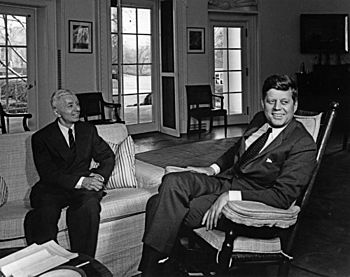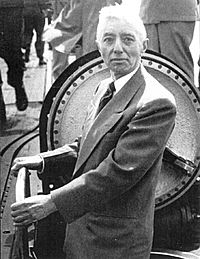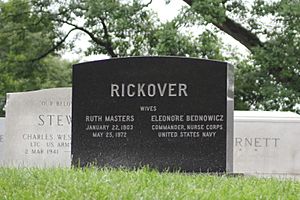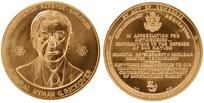Hyman G. Rickover facts for kids
Quick facts for kids
Hyman G. Rickover
|
|
|---|---|

Rickover pictured in 1955 as a rear admiral
|
|
| Birth name | Chaim Godalia Rickover |
| Nickname(s) | "Father of the Nuclear Navy"; "The Kindly Old Gentleman," or simply "KOG" |
| Born | January 27, 1900 Maków Mazowiecki, Congress Poland |
| Died | July 8, 1986 (aged 86) Arlington, Virginia |
| Allegiance | United States |
| Service/ |
United States Navy |
| Years of service | 1918–1982 |
| Rank | Admiral |
| Commands held | USS Finch Naval Reactors |
| Battles/wars | World War II |
| Awards | Navy Distinguished Service Medal (3) Legion of Merit (2) Congressional Gold Medal (2) Presidential Medal of Freedom Enrico Fermi Award |
| Spouse(s) | Ruth D. Masters (1931–1972 (her death); 1 child) Eleonore A. Bednowicz (1974–1986 (his death)) |
Hyman G. Rickover (January 27, 1900 – July 8, 1986) was a very important admiral in the United States Navy. He is often called the "Father of the Nuclear Navy." This is because he led the creation of nuclear power for Navy ships. He also managed how these ships operated for 30 years.
Rickover also helped build the Shippingport Atomic Power Station. This was the world's first power plant to use a special type of nuclear reactor to make electricity. He served in the Navy for an amazing 63 years. This makes him the longest-serving officer in U.S. military history. He was also one of only four people to receive two Congressional Gold Medals. Thanks to his strict rules, the U.S. Navy has never had a nuclear reactor accident.
Contents
Early Life and Education
Hyman G. Rickover was born Chaim Godalia Rickover in Maków Mazowiecki, Poland. His family was Jewish. They changed his name to Hyman, which means "life." In 1906, his family moved to New York City to escape problems in Poland. They later moved to Chicago, where his father worked as a tailor.
Hyman started working at age nine. He earned a small amount of money holding a light for a neighbor. He also delivered groceries. He finished grammar school when he was 14. Rickover graduated from John Marshall Metropolitan High School in Chicago in 1918. He then worked as a telegraph boy. This job helped him meet a Congressman who nominated him for the United States Naval Academy. Even though he was a third choice, he passed the test and was accepted.
Rickover began his Navy career in 1918 at the Naval Academy. He graduated in 1922 and became an ensign. He quickly showed he was a hard worker. He became an engineer officer on the destroyer La Vallette. This made him the youngest engineer officer in his group.
He later served on the battleship Nevada. He then earned a master's degree in electrical engineering from Columbia University. In 1931, he married Ruth D. Masters. Rickover decided to join the submarine service because young officers there were promoted quickly. He served on the submarines S-9 and S-48. He even saved a man from drowning while on the S-48. He also translated a German book about submarines, which became important for the U.S. submarine service.
In 1937, Rickover commanded the minesweeper Finch in China. His ship helped protect American citizens during a conflict between Chinese and Japanese forces. After this, he became an engineering duty officer. This meant he would focus on engineering tasks rather than commanding ships.
During World War II, Rickover helped repair the electrical power plant of USS California at Pearl Harbor. He was promoted to commander and then temporary captain. He also helped manage a ship repair facility in Okinawa. His work during the war, especially leading large development programs, earned him a Legion of Merit award.
Developing Nuclear Power for Ships
After World War II, Rickover became very interested in using nuclear power for ships. He worked with General Electric to develop a nuclear engine for destroyers. He believed nuclear power would be perfect for submarines. His idea was not popular at first. But he went directly to Fleet Admiral Chester Nimitz, who understood his vision. Nimitz supported the project to build the world's first nuclear-powered ship, USS Nautilus.
Rickover became the head of a new Nuclear Power Division. He also worked with the Atomic Energy Commission. This allowed him to lead the development of the Nautilus. He was known for being very determined. He and his team created a reliable nuclear reactor small enough to fit into a submarine. The Nautilus was launched in 1954.
Expanding Nuclear Power
Rickover also oversaw the creation of the Shippingport Atomic Power Station. This was the first nuclear power plant in the U.S. to produce electricity for homes. He was promoted to vice admiral in 1958. For the next 30 years, he had strong control over the nuclear Navy. He personally interviewed every officer who wanted to work on a nuclear ship. He interviewed tens of thousands of people.
In 1973, Rickover was promoted to a four-star admiral. This was rare for an officer who focused on engineering rather than direct combat command. His main job was to ensure reactor safety. After he retired, the leaders of Naval Reactors continued his focus on safety. They are also promoted to four-star admiral.
Amazing Safety Record
Rickover's very strict standards are why the U.S. Navy has never had a nuclear reactor accident. This means no uncontrolled release of dangerous materials from a reactor core. He often went on the first sea trials of almost every new nuclear submarine. After a nuclear accident at Three Mile Island in 1979, Rickover explained to Congress why the Navy's nuclear program had such a perfect safety record. This record is very different from the Soviet Union's, which had many nuclear submarine accidents.
Focus on Education

When Rickover was a child in Poland, he could not go to public schools because he was Jewish. He attended a religious school where he studied the Tanakh (Old Testament). Later in life, Rickover became very interested in improving education in the U.S. He believed it was important for national security, especially during the Cold War.
Rickover thought U.S. education standards were too low. He wrote a book called Education and Freedom (1959). In it, he said that education was "the most important problem facing the United States today." He believed that improving schools would help the country's future. He also wrote Swiss Schools and Ours (1962). In this book, he compared Swiss and American schools. He argued that Swiss schools had higher standards and produced better results.
After he retired, Rickover started the Center for Excellence in Education in 1983. He also founded the Research Science Institute in 1984. This is a summer science program for talented high school students from around the world. It is held at the Massachusetts Institute of Technology.
Forced Retirement
By the late 1970s, Rickover had many powerful friends in Congress. This helped him stay on active duty longer than most admirals. However, the Secretary of the Navy, John Lehman, felt Rickover was holding back the Navy.
Secretary Lehman eventually decided to force Rickover to retire. This was partly because Rickover was against paying certain submarine construction claims. Also, he was very old, and his political power was fading. In 1981, Rickover made an operational error during a submarine sea trial. This gave Lehman the final reason to end his career. On January 31, 1982, just after his 82nd birthday, Rickover was forced to retire. He had served for 63 years under 13 presidents. Rickover said he found out about his retirement from his wife, who heard it on the radio.
A year later, a party was held to honor Admiral Rickover. Three former U.S. Presidents attended: Nixon, Ford, and Jimmy Carter. All three had served as officers in the U.S. Navy.
Public Image
Rickover was known as "the most famous and controversial admiral of his time." He was very active, direct, and demanding. He expected a lot from others, no matter their rank. He did not like average work or foolishness. He often argued with senior Navy officers. Because of this, he was almost not promoted to admiral. It took help from the White House and Congress for him to get the promotion.
Rickover had great power over the U.S. nuclear fleet. He had to approve a crew's ability to operate a reactor safely. This meant he could stop a warship from being used if he thought the crew wasn't ready. Some people felt he sometimes used his power to get back at others.
Death
Hyman G. Rickover passed away at his home in Arlington, Virginia, on July 8, 1986. He was 86 years old. He was buried in a private ceremony at Arlington National Cemetery. A larger memorial service was held later. President Carter, other important leaders, and about 1,000 people attended.
Rickover is buried with his first wife, Ruth. The name of his second wife, Eleonore, is also on his gravestone. He is survived by his son, Robert Rickover.
Honors
The Los Angeles-class submarine USS Hyman G. Rickover (SSN-709) was named after him. It was commissioned two years before he died. At that time, it was one of only two Navy ships named after a living person since 1900. Another submarine, USS Hyman G. Rickover (SSN-795), was also named in his honor. It was christened in 2021.
Rickover Hall at the United States Naval Academy houses engineering departments. The Rickover Center at Naval Nuclear Power Training Command helps train Navy personnel. Other things named after him include a fellowship at M.I.T., the Hyman G. Rickover Naval Academy, and Rickover Junior High School.
Awards
Warfare Insignia
| Submarine Warfare Insignia (Dolphins) |
Decorations and Medals
| Navy Distinguished Service Medal with two Gold Stars | |
| Legion Of Merit with one Gold Star | |
| Navy and Marine Corps Commendation Medal | |
| Army Commendation Medal | |
| Presidential Medal of Freedom | |
| World War I Victory Medal | |
| China Service Medal | |
| American Defense Service Medal | |
| American Campaign Medal | |
| Asiatic-Pacific Campaign Medal | |
| World War II Victory Medal | |
| Navy Occupation Service Medal with "ASIA" clasp | |
| National Defense Service Medal with one Bronze Star |
- Congressional Gold Medal – 2 awards (1958, 1982)
Foreign Order
| Honorary Commander of the Order of the British Empire |
In 1946, he was made an Honorary Commander of the Order of the British Empire by King George VI for his service during the war.
Other Awards
Admiral Rickover received two Congressional Gold Medals. This is a very high honor for public service. He was one of only three people to receive more than one. In 1980, President Jimmy Carter gave him the Presidential Medal of Freedom. This is the highest non-military honor in the United States.
He also received 61 civilian awards and 15 honorary degrees. These include the Enrico Fermi Award for his leadership in developing safe nuclear power.
Documentaries
- Admiral Rickover – 60 Minutes interview by Diane Sawyer (1984)
- Rickover: The Birth of Nuclear Power by Michael Pack – a documentary shown in 2014 on PBS.
See Also
 In Spanish: Hyman Rickover para niños
In Spanish: Hyman Rickover para niños
- Operation Sandblast
- President Jimmy Carter's naval career
- Naval Nuclear Power School
- Y-12 National Security Complex




